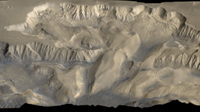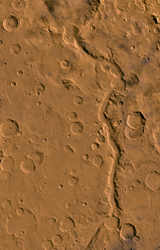









  


|
The Quest to Understand Mars

 As long as humans have explored
the planets, from the time of crude telescopes through the age of sophisticated
robotic spacecraft, Mars has stirred great scientific and human interest.
As early as the mid-1600's, the astronomers Huygens and Cassini were able to note the planet's
major markings and determine its rotation period. Based on observations
of Mars between 1777-83, William Herschel suggested that Mars has a thin
atmosphere, polar ice caps, and seasons similar to Earth's. In 1877,
Schiaparelli
made detailed maps of Mars' surface and popularized the notion that long
canali, or channels, cover the surface. But it was nineteenth-century
astronomer Percival Lowell's description of an Earth-like Mars, criss-crossed
with long canals and covered with seasonal vegetation, that drew an intense
public interest in Mars (this drawing comes from his book Mars).
Lowell's books describing civilizations on
Mars were among the most popular scientific writings at the turn of the
century, yet many scientists of his day felt that he crossed the line between
science and science fiction. As long as humans have explored
the planets, from the time of crude telescopes through the age of sophisticated
robotic spacecraft, Mars has stirred great scientific and human interest.
As early as the mid-1600's, the astronomers Huygens and Cassini were able to note the planet's
major markings and determine its rotation period. Based on observations
of Mars between 1777-83, William Herschel suggested that Mars has a thin
atmosphere, polar ice caps, and seasons similar to Earth's. In 1877,
Schiaparelli
made detailed maps of Mars' surface and popularized the notion that long
canali, or channels, cover the surface. But it was nineteenth-century
astronomer Percival Lowell's description of an Earth-like Mars, criss-crossed
with long canals and covered with seasonal vegetation, that drew an intense
public interest in Mars (this drawing comes from his book Mars).
Lowell's books describing civilizations on
Mars were among the most popular scientific writings at the turn of the
century, yet many scientists of his day felt that he crossed the line between
science and science fiction.
Ideas of civilizations and Earth-like
life were dashed when the first spacecraft to reach Mars revealed
a dry, cold, moon-like landscape. Mariner 4 flew
by the planet in 1965 and returned a few images of the southern cratered
highlands. Scientists noted how the spacecraft's radio signal diminished
as Mars passed between it and the Earth, calculating that Mars' atmospheric
pressure was 150 times less than Earth's. Mariners 6 and 7 in 1969 returned
many images that showed more varied landscapes. An infrared radiometer
found that the temperature of the south polar cap was 150 K (-193 F),
definitively
showing that it was composed of solid carbon dioxide, not water ice. In
1971-72, Mariner 9 conducted the first global mapping of Mars' surface
and atmosphere from orbit. A vast number of features and phenomena were
seen for the first time, revolutionizing the current view of Mars. Meanwhile,
the Soviet Union launched an ambitious series of probes to Mars with some
novel results, although all unfortunately prematurely failed.
 The landmark spacecraft missions
to Mars were the pair of Viking Orbiters and Landers which arrived in 1976.
The orbiters mapped the entire surface at all seasons, measured the amount
and distribution of atmospheric water vapor through time, determined the
thermal properties of all surface materials including ices, and monitored
dust storms. Their discoveries included the fact that, unlike
the south, the north polar cap
was composed of water ice. The primary goal of the landers
was to conduct biology experiments designed to detect signs of past or
present life. No unambiguous signs of biological activity were found.
The landers also returned imagery and meteorology from the surface for
the first time. The landmark spacecraft missions
to Mars were the pair of Viking Orbiters and Landers which arrived in 1976.
The orbiters mapped the entire surface at all seasons, measured the amount
and distribution of atmospheric water vapor through time, determined the
thermal properties of all surface materials including ices, and monitored
dust storms. Their discoveries included the fact that, unlike
the south, the north polar cap
was composed of water ice. The primary goal of the landers
was to conduct biology experiments designed to detect signs of past or
present life. No unambiguous signs of biological activity were found.
The landers also returned imagery and meteorology from the surface for
the first time.
 While these spacecraft did not find
aqueducts, civilizations, or even bacteria, they did find
signs of a past era that must have been quite different from the present.
The older highlands, which cover roughly the southern hemisphere of Mars,
are dissected by networks of valleys
that, although now dry, were probably formed by flowing water. In other
locations there is evidence for massive flooding, larger than any floods
on Earth, that carved wide paths through the landscape. The valley networks
and the flood channels flow into the northern plains of Mars, yet there
is no sign of the vast volumes of water that they once carried. Has this
water been frozen into an ocean beneath northern plains, locked in the
polar ice caps, or lost to space? Why was liquid water once so abundant but
now is completely absent? The Mars Polar Lander mission continues the
quest to understand Mars by addressing these and other questions left
unanswered by previous explorations. While these spacecraft did not find
aqueducts, civilizations, or even bacteria, they did find
signs of a past era that must have been quite different from the present.
The older highlands, which cover roughly the southern hemisphere of Mars,
are dissected by networks of valleys
that, although now dry, were probably formed by flowing water. In other
locations there is evidence for massive flooding, larger than any floods
on Earth, that carved wide paths through the landscape. The valley networks
and the flood channels flow into the northern plains of Mars, yet there
is no sign of the vast volumes of water that they once carried. Has this
water been frozen into an ocean beneath northern plains, locked in the
polar ice caps, or lost to space? Why was liquid water once so abundant but
now is completely absent? The Mars Polar Lander mission continues the
quest to understand Mars by addressing these and other questions left
unanswered by previous explorations.
|

